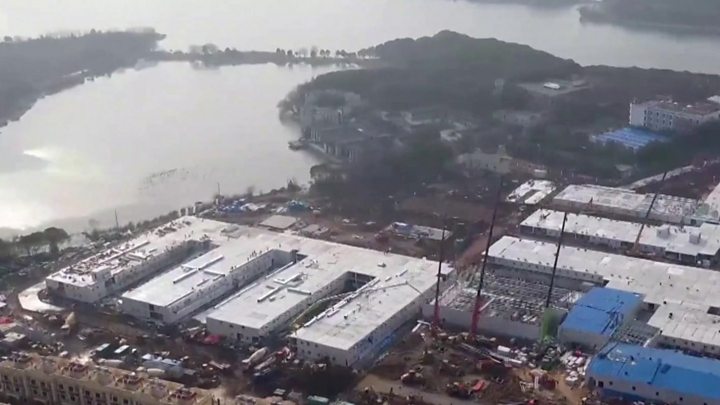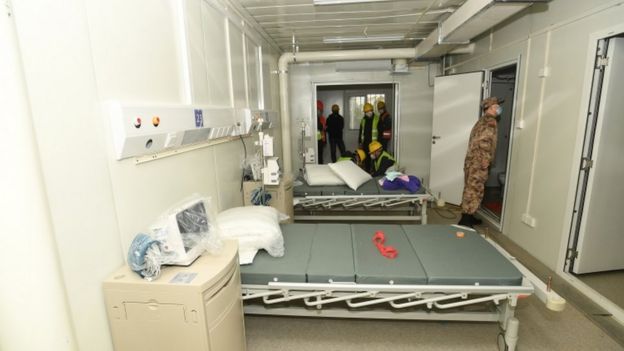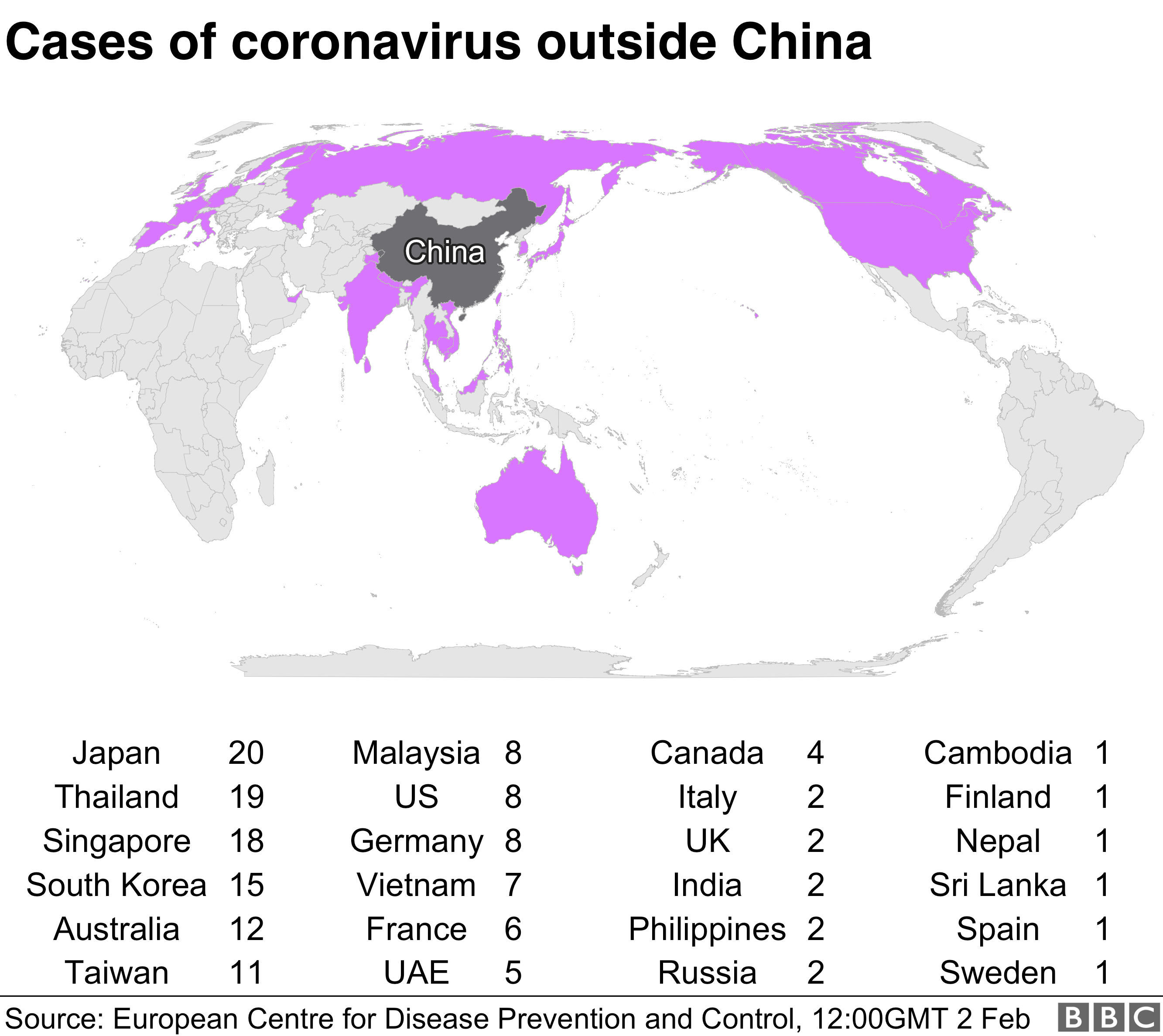3 Feb 2020

(See https://healthticket.blogspot.com/2020/02/time-lapse-shows-wuhan-hospital-built.html )
China is set to open a new hospital in the city at the centre of the coronavirus outbreak, as the numbers of people infected continue to grow.
Wuhan's 1,000-bed Huoshenshan Hospital, built in just eight days, is one of two dedicated facilities being constructed to help tackle the outbreak.
China is struggling to deal with the virus, with more than 17,000 confirmed cases and 361 deaths.
Sunday saw the first confirmed fatality outside China, in the Philippines.
The patient was a 44-year-old Chinese man from Wuhan who appeared to have been infected before arriving in the Philippines.
Many countries have barred foreigners arriving from China and are quarantining their own citizens.
Latest figures from China's National Health Commission on Monday revealed that, alongside the confirmed cases, there were:
- 21,558 suspected cases
- 152,700 people "under medical watch"
- 475 people discharged from hospital
There have been more than 150 confirmed cases of the virus outside China.
Hospitals in the province of Hubei - where Wuhan is located - are reportedly overwhelmed and struggling to treat the growing number of patients.
- The hospital built in a matter of days
- Can people recover from coronavirus? And other questions
- A visual guide to the outbreak
On Monday, hundreds of non-essential medical workers in Hong Kong went on strike - demanding that the territory's border with mainland China be completely closed.
The territory's authorities have refused, citing World Health Organization recommendations to introduce screening at borders - rather than closing them.
A newly formed medical union said frontline workers - including doctors and nurses - would strike on Tuesday if their demands were not met.
The number of coronavirus cases worldwide has overtaken that of the similar Sars epidemic, which spread to more than two dozen countries in 2003.
But the mortality rate of the new virus is much lower, suggesting it is not as deadly.
What do we know about the new hospital?
 EPA
EPA
Chinese state media reported on Sunday that construction of the new Huoshenshan hospital had been completed, and that it would open on Monday.
Local TV reports said 1,400 Chinese army medical staff, some with experience of infectious diseases, were arriving in Wuhan and being transferred to the new site.
A second hospital at Leishenshan is due to be finished on Wednesday.
What's it like in hospitals in Hubei?
Hospitals in the province are reportedly understaffed and overburdened, as the number of infections rises sharply.
According to the Washington Post, some hospital workers have begun wearing nappies because they don't have time to use the bathroom.
Hospitals are also dealing with a shortage of medical supplies. The Wuhan Children's Hospital posted on social media: "Medical supplies are in short supply - help!"
Videos on social media showed long queues outside hospitals.
In one video, a man with a Wuhan accent at a local hospital said it could take "as long as 10 hours" for patients to be seen by a doctor.
How deadly is the virus?
More than 75,000 people may have been infected in the city of Wuhan, which is at the epicentre of the outbreak, experts say.
But estimates by the University of Hong Kong suggest the total number of cases could be far higher than the official figures.
- Diary of a life in locked-down Wuhan
- Coronavirus: What it does to the body
- Wuhan: The London-sized city where the virus began
A report on the early stages of the outbreak by the Lancet medical journal said most patients who died from the virus already had pre-existing conditions.
The report found that, of the first 99 patients treated at the Jinyintan Hospital in Wuhan, 40 had a weak heart or damaged blood vessels. A further 12 had diabetes.
The virus causes severe acute respiratory infection and symptoms seem to start with a fever, followed by a dry cough.
But most people infected are likely to fully recover - just as they would from a normal flu.
An expert at China's National Health Commission (NHC) said that one week was sufficient for a recovery from mild coronavirus symptoms.

Which countries are restricting arrivals?
Various countries have imposed travel restrictions to a varying degree.
- Denying entry to all foreign visitors who have recently been to China: US, Australia, Singapore
- Denying entry to foreigners travelling from mainland China: New Zealand, Israel
- Denying entry to foreigners who have visited Hubei province: Japan, South Korea
Other countries have seen their national carriers temporarily suspend all flights to mainland China. These include Egypt, Finland, Indonesia, the UK, and Italy amongst others.

In the US, citizens and residents returning from Hubei will be quarantined for 14 days.
The Pentagon said it would provide housing for 1,000 people who may need to be quarantined after arriving from abroad.
Australia said any of its own citizens arriving from China would also be quarantined for two weeks.
Do the travel bans work?
Global health officials have advised against the bans.
"Travel restrictions can cause more harm than good by hindering info-sharing, medical supply chains and harming economies," the head of the WHO said on Friday.
The WHO recommends introducing screening at official border crossings. It has warned that closing borders could accelerate the spread of the virus, with travellers entering countries unofficially.
China has criticised the wave of travel restrictions, accusing foreign governments of ignoring official advice.
https://www.bbc.com/news/world-asia-51349154